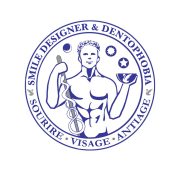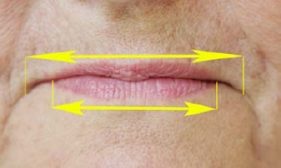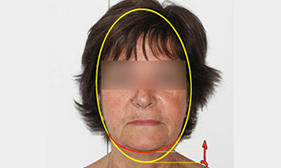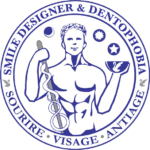YOUR FACE CAN'T BE REJUVENATED BY AESTHETIC MEDICINE?
THE ATTRITION OR ABSENCE OF YOUR TEETH CAUSES YOUR JAWS TO COME TOGETHER
THANKS TO THE INCREASE IN THE VERTICAL DIMENSION OF THE BITE, YOU WILL FIND YOUR FACE RADIANT WITH VITALITY
how to rejuvenate the face by repositioning the chin:
Increasing the Vertical Bite Dimension - dvo
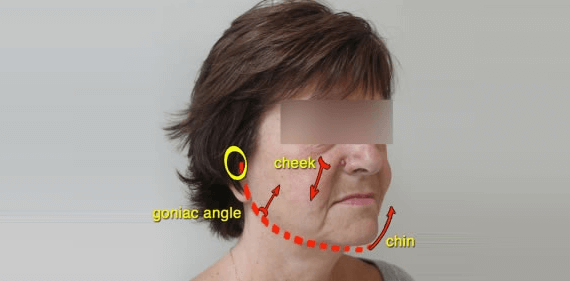
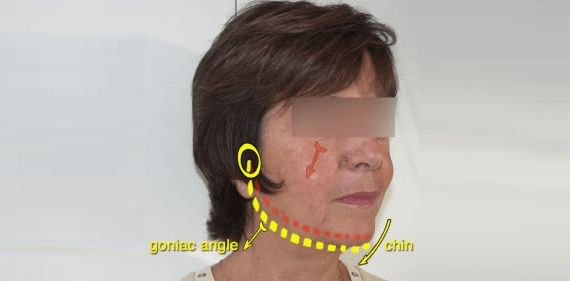
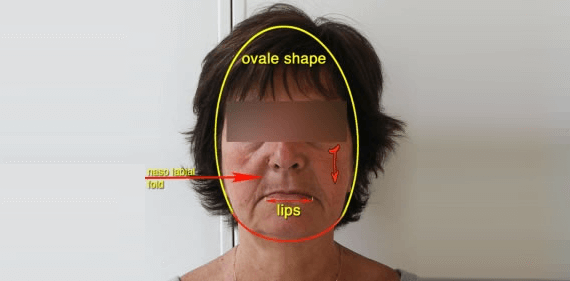
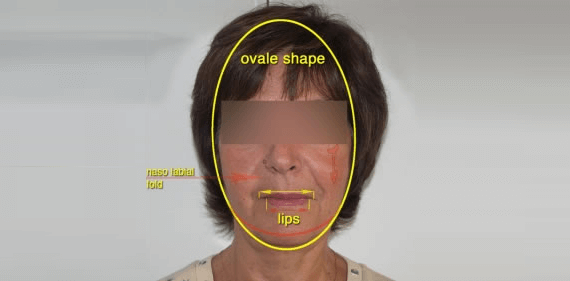
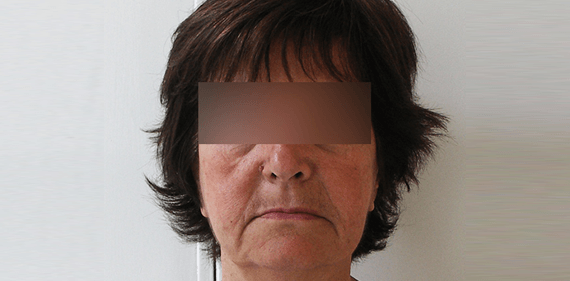
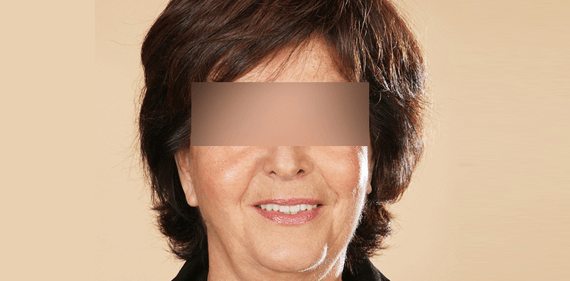
"WRINKLES SHOULD SIMPLY BE THE IMPRINT OF SMILES"
MARK TWAIN
DO YOU HAVE THESE SIGNS OF AGEING ON YOUR FACE?
DO YOU HAVE THESE SIGNS OF AGING ON YOUR FACE?
In this case, your face does not only require a rejuvenation by classic aesthetic medicine techniques, such as for example: injections of “filer” or “Botox” or “tensor threads”!
The problem does not only concern the soft tissues (skin) but also the skeletal structure of the jaws:
It is not just the soft tissues, such as skin and connective tissue, that have become distended and aged.
The problem also comes from a destructuring of your skeletal bases of the face!
The disharmony of your face is due to the fact that your jaws have come together, because your teeth are totally or partially lost or because you have worn them out (attrition): this parafunction is called bruxism.
The main rejuvenation treatment for your face involves restructuring the harmony of the lower part of your facial skeleton and correcting the closing of the jaws, which is inevitable in these cases. This situation is called: “the decrease (loss) of the Vertical Dimension of Occlusion” or VDO.
As you can see from the before and after pictures of our “sample case”: cosmetic dentistry treatments or in other words “smile and facial anti-aging” or “smile rejuvenation” or “Smile design“, have two main themes:
- Regeneration and restructuring of soft tissues: the skin in general, cheeks and lips, which are within the competence of the aesthetic doctor.
- Reconstruction and repositioning of hard tissues: mainly teeth and jawbone bases, which are the responsibility of the cosmetic dentist.
These techniques will be explained and demonstrated in this chapter devoted to the participation of dentistry in facial anti-aging.
THE SEARCH FOR FACIAL AESTHETICS OR "SMILE DESIGN".
The harmony of the face is achieved by restructuring the lower part of the facial skeleton and correcting the approach of the jaws, called "the loss of the Vertical Bite Dimension".
The hard tissues of the face participate in the expression of the smile. That is to say essentially the teeth and the maxillary bone bases (the upper jaw and the mandible).
A destructuring of these tissues leads to a disharmony of the face.
Their restructuring leads to a rejuvenating effect of the facial expression and the smile.
Prosthetic reconstructive treatments of the dental arches can correct jaw spacing defects, called Vertical Bite Dimension or VBD.
The soft tissues of the face participate in the expression of the smile. That is, the skin in general, the cheeks and lips, can be harmonized by rejuvenation restructuring. They are performed with fillers(hyaluronic acid), tensor threads,botox (botulinum toxin)injections or by chemical and/or biological cosmetic rejuvenation treatments (PRP, PRF, Stem cells) and/or LASER, (among other techniques).
These treatments are carried out in cooperation between the cosmetic dentist and aesthetic doctors or even cosmetic surgeons depending on the techniques used.
The hard tissues of the face involved in the expression of the smile are essentially the teeth and the maxillary bone bases (the upper jaw and the mandible). These anatomical parts articulate with each other. These joint relationships can be harmonized by rejuvenation restructuring, performed through dental prosthetic reconstructions. They correct jaw spacing defects called Vertical Bite Dimension or VBD.
As a result, they correct the defects of harmony of the smile and rejuvenate the expression of the face.
TWO THERAPEUTIC STRATEGIES
Anti-aging treatments, in the strict sense, are all conventional dental reconstruction techniques, such as the placement of ceramic crowns or bridges, the placement of dental implants bearing crowns or bridges. But in this discipline, there is a increased search for aesthetic perfection.
These are also specifically aesthetic treatments, such as ceramic dental veneers.
Anti-aging treatments of the skeletal masses that contribute to the aesthetic expression of the smile and the face are essentially those that concern the restructuring of the volume, the positioning and the spacing of the two jaws: the upper jaw and the lower jaw (or mandible).
There are two types of anti-aging dental treatments for the smile and face:
Firstt : Corrections for loss of intrinsic jaw volume.
It is the loss of volume in the maxillae and related tissues as a result of substance loss. The correction of these losses is done thanks to the techniques of plastic, reconstructive and aesthetic dental surgery of the bony bases and the soft tissues which cover them (mucous membrane and attached gum), such as for example: all the techniques of pre-implant bone grafts, gum grafts.
Secondt : Corrections for extrinsic volume loss in the maxillae.
It is the loss of volume of the lower face, following the bringing together of the jaws as a result of total or partial loss of dental substance and/or loss of substance of the maxillary bases.
The correction of this loss of OVD consists in going the other way around by enhancing the Vertical Bite Dimension or VBD.
It is this particular topic of facial and smile rejuvenation treatment through dental treatments, in the strict sense, that will be developed in the following chapter.
The Smile design, that is to say the conception and the realization of the corrections of the defects of harmony of the smile and the face, passes obligatorily by the analysis of the ageing defined in these preceding topics in order to obtain a pretty face illuminated by beautiful smile.
Smile designer & dentophobia’s team of aesthetic dentists has organized a technical platform in order to be able to manage the restructuring and embellishment of the tissues in these different areas of the face.
We also have teams of practitioners specialized in all specialties related to cosmetic dentistry such as physicians and cosmetic surgeons. They are likely to work in synergy harmoniously.
RESTRUCTURING OF THE VERTICAL DIMENSION OF OCCLUSION (DVO)
REJUVENATION OF THE FACE AND SMILE BY CORRECTING THE MELTING OF THE FACIAL SKELETON.
When facial rejuvenation specialists, such as dentists, physicians and cosmetic surgeons, do their initial aesthetic analysis, they must take into consideration the melting of the volume of the face which is either physiological or pathological.
The physiological melting due to age is, on the one hand, that of the soft tissues through the reduction of facial fat but also, the melting of the facial skeletal mass.
Physiological bone loss due to age leads to a loss of volume mainly in the anterior-posterior direction and in the width.
The pathological melting due to age corresponds most of the time to a loss of volume in the vertical direction. It is essentially due to the approach of the jaws, following the aging of the teeth.
That is to say, that all the teeth of the dental arch have a decreased height, because of their partial or total disappearance, or their exaggerated wear, because of an untimely grinding, which we call bruxism.
– Plastic surgeons and aesthetic physicians rejuvenate the face primarily by restructuring the volume losses of the soft tissues of the face.
– Aesthetic-conscious dentists rejuvenate the face mainly by restructuring the loss of volume of the facial skeletal mass and in particular, in the vertical direction of the lower face.
The teeth of the smile must be set in a volume that restores the harmony of the oval of the lower part of the face.
By reconstructing the teeth that make up the dental arches in a corrected volume, cosmetic dentists restructure the Vertical Bite Dimension disrupted by tooth loss or wear.
REJUVENATION OF THE SMILE BY RESTRUCTURING THE HARMONY OF THE SKELETAL SMILE.
Facial rejuvenation is based on a combination of medical treatments including facial soft tissue remodeling (performed by cosmetic surgeons and physicians) and restoration of proper jaw spacing (performed by cosmetic dentists).
Restructuring the harmony of the skeletal smile involves replacing missing or worn teeth.
Aesthetic-conscious dentists reconstruct dental arches that have been partially or totally destroyed by tooth decay or wear due to bruxism, in an appropriate volume. This allows for the restructuring of the proper jaw spacing and thus the height of the lower part of the facial skeletal volume: the skeletal smile.
The Vertical Occlusion Dimension is the distance between the base of the nose and the tip of the chin. The distance between these two points defines the height of the lower face.
The face has three levels: upper, middle and lower. The harmony of the face depends on the respect of the proportions between these three levels of the face. Some cosmetic surgeons introduce the golden ratio into the ideal proportions of the face.
Wear and tear or partial and/or total loss of teeth leads to the jaws coming together. That is to say, a loss of the Vertical Occlusion Dimension, thus a settling of the lower level of the face with a consequent loss of the oval of the face and an abnormally aged aspect of the facial expression and the smile.
The aging of the lower floor or skeletal smile, disturbs the vertical proportions of the face and therefore the aesthetic harmony of the whole smile expression.
YOU ARE UNIQUE!
DISCOVER the enhancement of the vertical dimension of occlusion to rejuvenate your face
THE MECHANISMS AND CONSEQUENCES OF THE APPROACH OF THE JAWS
The approach of the jaws leads to the collapse of the lower part of the face with the following consequences:
- A crushing of the lips against each other;
- A loss of the oval of the face;
- Possibly ptosis of the cheeks or jowls.
It is these consequences of the decrease in the Vertical Bite Dimension or VBD that we must correct.
There are many causes for the jaws to come together: Wear and tear due to age or bruxism (i.e. clenching or grinding of the teeth), destruction of the teeth by dental caries, bone resorption of the jaws following extractions or cysts, iatrogenic dental care.
All these phenomena can have multiple consequences on your health and on the aesthetics of your teeth, your smile and your face.
The therapeutic tools to correct this decrease of the vertical dimension of occlusion are the placement of ceramic veneers, ceramic crowns and bridges, inlay or onlay or table top (a kind of occlusal veneer). Dental implants, pre-implant bone grafts and sinus fillings are all part of the reconstruction of the dental arches.
The use of intravenous vigorous sedation techniques(see the chapter on dental sedation) allows dental phobic patients to be treated for simple or complex treatments. The presence of an anesthesiologist who performs the sedation, allows for safe and comfortable prosthesis placement or light oral surgery or heavy.
When the correction of the DVO is not sufficient to restore facial harmony, additional soft tissue restructuring must be considered. In particular, to fill in the hollowed areas of the cheeks and the “valley of tears”, hyaluronic acid injections can be performed by cosmetic dentists.
In the case of significant ptosis of the cheeks or thinning of the face, doctors or aesthetic surgeons are given the task of restructuring the face by placing notched tensor threads or lifting with lipostructure to fill in the hollowed areas of the cheeks.
Regenerative medicine and dentistry is taking its place thanks to PRP and/or PRF and/or Stem cell injections with lipostructure to firm up and help regenerate the tissues of the face and more particularly the cheeks and lips.
THE ORIGINS OF THE APPROACH OF THE JAWS
The impression of premature aging of the face and smile is due to a destructuring of the harmony of the facial tissues that constitute the skeletal smile and the connective and skin smile.
The soft tissue (skin) component is more the responsibility of physicians and cosmetic surgeons. However, the skeletal component, particularly at the level of the lower part of the facial bone mass, is the responsibility of the aesthetic-conscious dentists because the main causes of this destructuring are dental or adjacent tissue.
Wear and tear from bruxism, cavities and tooth extractions
Bruxism is one of the main causes of tooth wear. One of its origins is in ordinary stress.
Wear and tear due to age or teeth grinding (bruxism) reduces the height of the teeth. On the picture, on the right, the patient has worn down his teeth almost to the gum: Bruxism, especially at night, is a very destructive self-mutilation behavior of the dental organs.
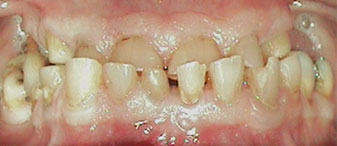
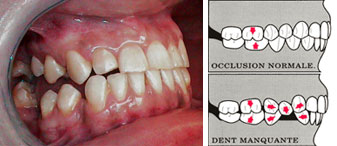
The destruction of teeth by decay
The destruction of teeth, due to lack of proper care or extractions, contributes to the jaws coming together.
Jaw bone resorption after dental extractions
Jaw bone resorption is inevitable after tooth extraction. The bone volume of the lower part of the facial skeleton decreases.
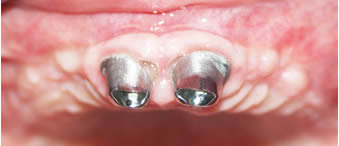
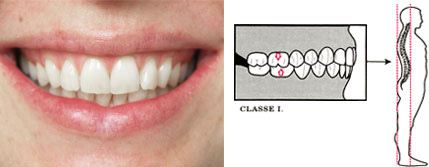
The perfect anatomical type: Angle Class I
CLASS I or normal occlusion: It does not promote premature aging of the face. In addition, it allows a good posture of the head and the back.
OTHER anatomical types: Angle Class II and III
CLASS II : the upper teeth are in front. It leads to the embedding of the lower arch in the upper arch. The head is often pushed forward.
CLASS III leads to the embedding of the lower arch in the upper arch. The head is often pushed backwards.
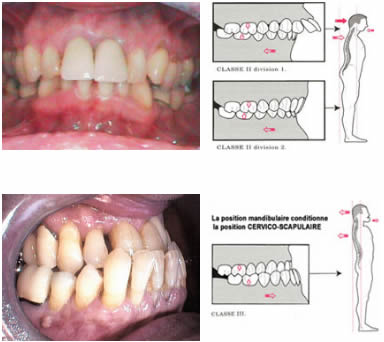
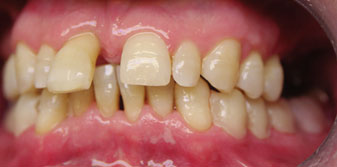
The combination of all the problems
We can have a little bit of everything: Tooth wear is favored by a posterior edentulousness. Lower jaw embedding is favored by a Class II. The indentation and the approach of the jaws forced the patient, to chew, to propel his lower jaw forward, so the upper incisors did not resist to this pressure and became loose by tilting forward!
The disharmony is complete and the loss of aesthetics is an obvious corollary.
THE BRINGING TOGETHER OF THE JAWS: THE GENERAL CONSEQUENCES
On health: Many osteopathic disorders are due to the approach of the jaws. The destructuring of the entire muscular and articular mechanics of the head, neck and upper trunk leads to intense physical fatigue and chronic or acute pain.
On the psyche : The loss of aesthetics following the sagging of the face and the impression of premature aging of the smile and the face acts on the mind and increases the risk of depression and loss of self-esteem.
On the body: According to traditional Chinese medicine, there are links between :
- Teeth and kidneys
- Lips and spleen
- The nose and lungs
- Facial muscles and liver
- The word and the heart
On the head:
- Resorption of the facial bone mass
- Less attractive smile
- Facial soft tissue collapse
- Deterioration of the joints
Deterioration of the jaws leads to joint problems, particularly the temporomandibular joint or TMJ (in front of and below the ear canal). Parafunctions (such as bruxism: grinding or clenching of the teeth) accelerate this process. Stress is a cause or an aggravating factor in these behaviors.
The main joint problem in the temporomandibular joint or TMJ is that the head of the lower jaw joint (condyle) moves abnormally in the cranial part of the joint (glenoid cavity) and causes wear of the cartilage which can lead to a hernia or a fracture of the TMJ meniscus.
- Headaches;
- Sleep apneas;
- Cracking or popping in the joints;
- Painful contractures of the neck and shoulder muscles.
- Headaches;
- Sleep apneas;
- Cracking or popping in the joints;
- Painful contractures of the neck and shoulder muscles.
The different signs of aging observed on the lips
The different signs of aging on the face

Crushed lips: The lips are crushed against each other because the jaws are abnormally close together due to the wear of the teeth. The expression of the face is sad with the appearance of the wrinkles of bitterness.

The chin: The chin moves up and forward due to the rotation of the lower jaw around its axis (temporomandibular joint). The consequence is that the chin is too far forward and the facial expression resembles that of a prognathus.


Hemming of the lower lip: The upper lip moves back and becomes less visible. The lower lip is pushed forward. It is hemmed in and comes up on the upper lip. A horizontal wrinkle appears on the middle of the chin between the lower lip and the tip of the chin where the skin is folded.
Cheeks: The cheeks lose their tension and fall down forming a jowl. The nasolabial fold deepens due to the sagging of the cheek.
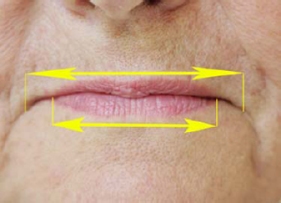
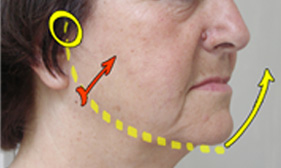
Apparent lip narrowing:
The true anatomical corners of the mouth no longer coincide with the visible corners of the mouth, which seem to move towards the middle of the mouth. The mouth and lips give the impression of being narrowed.
The gonial angle and the horizontal ramus of the mandible: The gonial angle and the horizontal ramus of the mandible move upward and forward, around their axis of rotation: the temporomandibular joint. The expression “square jaw” is lost.
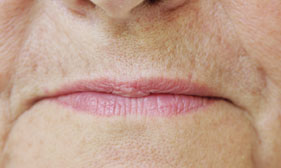

Apparent dryness of the lips: The boundary between the moist (mucous membrane) and dry (skin) parts of the lips recedes in the mouth. The mucosa disappears and only the dry part remains.
expected results and consequences
RESTRUCTURING THE VERTICAL DIMENSION OF THE FACE
The correction of the height of the lower part of the facial skeleton leads to the correction of the disharmony of the volume of the facial bone mass and restores not only the aesthetics and physiology of the dental arches (dentition) but also, as an obvious corollary, the aesthetic and physiological harmony of the smile and the face.
As a result, the impression of premature aging is erased, giving the patient back her true facial expression, unaltered by dental decay.
The patient is then free, if he or she wishes, to perfect this result with the help of anti-aging techniques used by doctors and aesthetic surgeons through hyaluronic acid injections or lipostructures associated or not with face lifts.
Once the skeletal component of the facial mass has been restructured, then and only then can doctors and cosmetic surgeons intervene on the soft tissues.
Reversing the timing of these protocols would be a major mistake in most cases. The initial analysis of the doctor or cosmetic surgeon would be distorted by not taking into account the dental decay, leading to additional destructuring of the soft tissues of the face, due to the fact that their bony support has been deformed.
In fact, everything happens as if, for example, a hanging (the soft tissues of the face: skin, lips) were distended or deformed because the wall support (the bony wall of the skeleton of the face on which the muscles and the skin are inserted) was itself deformed.
The consequence on the rejuvenation of the smile is obvious: only after the perfect surface and volume of the wall has been restored can the hanging be positioned correctly.
If and only if, after the wall is “redone”, defects of this hanging persist (such as jowls or ptosis of the face or neck) then it is necessary to act at this level as well.
This means that for this patient, in our example,fillerinjection techniques can be performed by cosmetic dentists in the perioral area or by doctors or cosmetic surgeons for the rest of the face, in soft tissues such as the connective tissue and the epidermis (skin) of the face.
REVERSING THE AGING PROCESS OF THE SMILE AND THE FACE:
THE COMBINATION OF DVO ENHANCEMENT AND ANTI-AGING MEDICINE
By restoring the anatomy of the dental arches worn out or destroyed by dental caries, we must restructure the volume of the facial bone mass and the aesthetics of the face by increasing the vertical dimension of the lower face.
This work allows to recover the physiology of mastication and theharmony of the smile and the face lost, thanks to prosthetic treatments, implant treatments and/or orthodontic treatments in possible association with orthognatic surgeries.
All of these treatments, possibly combined, correct the jawline and thus participate in the rejuvenation of the face and the expression of the smile.
These treatments are by nature global.
This means that they involve all aspects of dental surgery or dentistry: such as ceramic veneers, ceramic crowns and bridges, but also dental implants, pre-implant bone grafts and sinus fillings.
The crowns cosmetic ceramics and/or veneers dental ceramics and/or inlay-onlay are the aesthetic prosthetic tools of choice.
The bone grafts after dental extractions as well as the placement of dental implants are the necessary surgical tools if teeth have been lost or extractions had to be scheduled. These preparations and reconstructions of the jaws are the prerequisites for the successful placement of dental implants.
The harmony and beauty of the face are restored.
The face will be illuminated by a beautiful smile.
The melting of fatty tissue
With age, the melting of the fat that fills the skin of the face reinforces the impression of aging.
This is why ” fillers ” such as hyaluronic acid are necessary to rejuvenate the face by “filling in” the soft tissues, such as the cheeks and lips. In particular, to fill in the sunken areas of the cheeks and the “valley of tears”. Hyaluronic acid injections can be performed by cosmetic dentists.
The quality of the skin plays a role in aging
PRP and PRF injections in the cheeks and lips can improve the texture of the fleshy tissues.
PRP and PRF act by releasing growth factors and are involved in the cellular regeneration of tissues. PRP and PRF injections can be beneficial in firming and helping to regenerate facial tissues, especially the cheeks and lips.
The dental reconstruction protocol is explained in detail in the chapter dedicated to the “
clinical case of Corinne
“.
